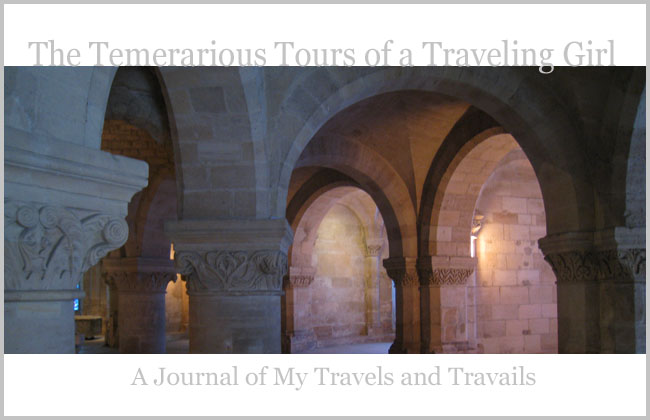Aachen, Germany was our last trip while in the Netherlands, and a place I've wanted to see since taking a medieval history course about Charlemagne while at St. Andrew's my sophomore year. The city of Aachen is about 45 minutes from Maastricht by car, just over the border in Germany, but despite the geographical proximity, the Dutch-German border has made the two feel very different. I didn't expect to get much of a taste of Germany by visiting Aachen since it is so close to the Netherlands, but my expectations were incorrect and left me wanting to see much more of Germany. The drive to Aachen from Maastricht took us through the country, a welcome change and very pretty after spending the past three weeks in cities.

 Farmland between Maastricht and Aachen (taken from the bus - apologies).
Farmland between Maastricht and Aachen (taken from the bus - apologies).It had rained all morning and was still grey and misty in Aachen, adding to the sense of atmosphere. The focal point of the trip was the cathedral of Aachen, in particular the Dom, or Palatine Chapel, built by Charlemagne in the 800s.
 Aachen Cathedral with the Palatine Chapel in the center.
Aachen Cathedral with the Palatine Chapel in the center.The Cathedral is the oldest in northern Europe and served as the site of German coronations throughout the Middle Ages. The octagonal Chapel originally served the royal palace which no longer stands but was connected to the Dom.

 The Dom - when it was built around 800, it was the largest dome north of the Alps.
The Dom - when it was built around 800, it was the largest dome north of the Alps.The decoration and architecture is very similar to that in Ravenna, particularly the shape and the elaborate mosaics, which makes sense because Charlemagne visited the last foothold of the Roman Empire in the West around 786. 

View of the Dom from the entrance of the Cathedral with Barbarossa's chandelier
prominently hung from the ceiling.
prominently hung from the ceiling.
 The sixteen-sided ambulatory that surrounds the octagonal center.
The sixteen-sided ambulatory that surrounds the octagonal center.
The eagle pulpit representing the Holy Roman Empire.
The Chapel was expanded during the later Middle Ages to accomodate the large numbers of pilgrims who came to the site to see the numerous relics collected by Charlemagne, including the cloak of the Virgin and the swaddling clothes of Christ. 

The altar with the glass chapel behind (15th century).
The decorations inside are a visible timeline of the history of the Holy Roman Empire with a gold and jeweled pulpit given by Henry II in 1014 and the Barbarossa chandelier, which hangs from the center of the ceiling of the Dom.
 Pulpit given by Henry II.
Pulpit given by Henry II.
The Barbarossa chandelier.
The chandelier represents the New Jerusalem described in Revelation but has only eight towers instead of the twelve described - an artistic adjustment so that the chandelier would fit into the octagonal chapel. The links of the chain suspending the chandelier increase in size as they near the ceiling, correcting the visual distortion of the chain narrowing as it recedes from the viewer. 

Chain of the chandelier and the 19th century restoration of the original ceiling.
The first thing to strike me about the Cathedral were the mosaics which cover every inch of the ceiling and sparkle in the darkness of the building. 







I can only imagine how they would have looked in the ninth century when illuminated with candlelight.



Mosaic depicting the four major rivers known by the Romans.

The Tigris - note the toga.
The Cathedral was much smaller than I had expected - granted only part of it was accessible due to restorations, but the Dom itself was quite compact and perfect for accomodating Charlemagne and his entourage. Given the chance, I could probably have spent all day in the Cathedral, but tempus fugit, so I spent the last two hours of the afternoon walking around the center of town and to the town hall, built in the 1300s and nearly destroyed by a fire in the late 1800s. 

The Town Hall from the Katschhof square.

The Town Hall from the Markt square.

Markt square from the Town Hall - the brownish building third from the left is the called the Grashouse and is the oldest secular building in Aachen.
It's amazing that the Cathedral, from the ninth century, and the Town Hall, from the 14th, have managed to survive Germany's tumultuous history.

No comments:
Post a Comment